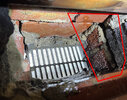I have what I believe to be an EPDM or similar rubber roof that is about 7 years old, installed a little over 3 years before I purchased the house in late 2020. It was not coated during the initial installation, and about 3 months after I became the owner, a substantial leak occurred in the upstairs ceiling around where the vent stack exits the building/roof. I attempted to get the original installer to come out and honor the then current warranty and provide a fix, but when I couldn't reach them I went ahead and patched what seemed like the obvious problem areas (cracks in existing flashing/cement) with a rubberized cement product & mesh tape. I don't recall this solving the problem entirely though, and I was finally able to get a hold of that original installer who suggested doing a silver coat because it had never been done. After doing that the leaking stopped.
Flash forward to this past March (3 years after the coating) and I"m finally getting around to replacing the ceiling areas that were damaged during that previous leak. I ripped down the damaged plasterboard and the "attic" space had been exposed for a few weeks, when during a big rain storm I noticed 3-4 areas of leaking. Two of which were emanating from a nail/split in the wooden roof layer (boards, not plywood), and one from a joist corner intersection - all of which were close to the sides of the house on opposing sides. There was also substantial leaking around one of the vents, where there has been obvious deterioration of the mortar in general:




Since the warranty on the rood had since expired, I went up to check for obvious points of water entry and saw several areas (near where the leaks were inside) where the roof material had open folds along joints. Given that the rest of the roof in general looks decent, I can only assume this is where water is getting in. There are a bunch but here are some of the more obvious locations:




It's really not in the cards for me to replace the entire roof this year, so I'm wondering if there is a reasonably easy way to repair these spots? Is it possible to just thoroughly clean the area and then inject/apply some sort of patching material (rubberized, silicone, etc), or is the only real way to cut these areas out entirely and apply a new piece of roofing material as a patch with new flashing cement? Either way, it seems like the silver coating might need to be scraped off/removed for anything to properly adhere?
Any knowledge/suggestions would be helpful, as if I cannot do this myself (ie. per a location roofing supplier, I can't even obtain the correct materials without a contractor license..), it would still be nice to know so if I get a diagnosis/quote from another roofer. If it makes a difference I am located in Baltimore, MD, USA and the house was built in the 1950's.
Thanks in advance!
Flash forward to this past March (3 years after the coating) and I"m finally getting around to replacing the ceiling areas that were damaged during that previous leak. I ripped down the damaged plasterboard and the "attic" space had been exposed for a few weeks, when during a big rain storm I noticed 3-4 areas of leaking. Two of which were emanating from a nail/split in the wooden roof layer (boards, not plywood), and one from a joist corner intersection - all of which were close to the sides of the house on opposing sides. There was also substantial leaking around one of the vents, where there has been obvious deterioration of the mortar in general:
Since the warranty on the rood had since expired, I went up to check for obvious points of water entry and saw several areas (near where the leaks were inside) where the roof material had open folds along joints. Given that the rest of the roof in general looks decent, I can only assume this is where water is getting in. There are a bunch but here are some of the more obvious locations:
It's really not in the cards for me to replace the entire roof this year, so I'm wondering if there is a reasonably easy way to repair these spots? Is it possible to just thoroughly clean the area and then inject/apply some sort of patching material (rubberized, silicone, etc), or is the only real way to cut these areas out entirely and apply a new piece of roofing material as a patch with new flashing cement? Either way, it seems like the silver coating might need to be scraped off/removed for anything to properly adhere?
Any knowledge/suggestions would be helpful, as if I cannot do this myself (ie. per a location roofing supplier, I can't even obtain the correct materials without a contractor license..), it would still be nice to know so if I get a diagnosis/quote from another roofer. If it makes a difference I am located in Baltimore, MD, USA and the house was built in the 1950's.
Thanks in advance!


